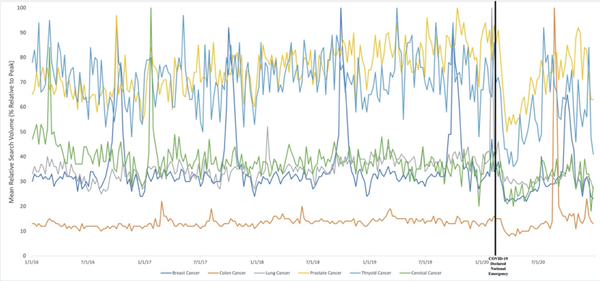-
Home
-
About JCTR
-
Gold Open Access
-
Issues
-
Editorial board
-
Author guidelines
-
Publication fees
-
Online first
-
Special issues
-
News
-
Publication ethics
-
Partners
-
Submit your manuscript
-
Submit your review report
-
Editorial Office
-

This work is licensed under a Creative Commons Attribution-NonCommercial 4.0 International License. ISSN print: 2382-6533 ISSN online: 2424-810X
Volume 7 Issue 6
Online public interest in common malignancies & cancer screening during the COVID-19 pandemic in the United States
Samuel A. Cohen*, Shayan Ebrahimian, Landon E. Cohen, Jonathan D. Tijerina
Cohen et al. J Clin Transl Res 2021; 7(6):4
Published online: November 6, 2021
Abstract
Background and aim: The COVID-19 pandemic was declared a national emergency in the United States in March 2020. The Centers for Medicare & Medicaid Services (CMS) subsequently released recommendations that healthcare facilities temporarily delay elective surgeries and non-essential medical procedures. Disruptions to medical care significantly impacted cancer patients, with cancer screenings halted and nonurgent cancer surgeries postponed as healthcare facilities shifted resources towards the COVID-19 pandemic. Although it has been reported that cancer screening rates decreased dramatically in the United States in 2020, it is unclear whether this trend was driven by factors related to public interest in cancer and/or cancer screening as opposed to other factors such as clinical backlogs, pandemic-related policies, and/or resource limitations. The purpose of this study was to use the Google Trends tool to evaluate public interest in six common malignancies and four common cancer screening methods during the COVID-19 pandemic.
Methods: We used the Google Trends tool to quantify public interest in six different malignancies (Breast Cancer, Colon Cancer, Lung Cancer, Prostate Cancer, Thyroid Cancer, and Cervical Cancer) and four cancer screening methods (Pap Smear, Lung Cancer Screening, Mammogram, and Colonoscopy) in the United States during the COVID-19 pandemic. Welch’s t-tests were used to compare monthly search volumes during the COVID-19 pandemic (2020) to the four years prior to the pandemic (2016-2019) for all ten search terms included in our study. We used Benjamini-Hochberg (BH) to adjust raw P values to account for multiple statistical comparisons. The level of statistical significance was defined by choosing a false discovery rate of .05.
Results: Our results indicate significantly reduced interest in all malignancies studied at the beginning of the COVID-19 pandemic. Public interest in [‘Breast Cancer’], [‘Colon Cancer’], [‘Lung Cancer’], [‘Thyroid Cancer’], and [‘Cervical Cancer’] significantly decreased in the months of March, April, May, and June 2020 when compared with public interest in 2016-2019. Public interest in cancer screening methods such as [‘Pap Smear’], [‘Lung Cancer Screening’], [‘Mammogram’], and [‘Colonoscopy’] significantly deceased in the months of April and May compared to 2016-2019 values. However, decreased public interest in cancer screening methods was temporary, with Google search volumes returning to pre-pandemic levels in June-December 2020.
Conclusion: There was significantly reduced public interest in both common malignancies and cancer screening methods at the beginning of the COVID-19 pandemic in the United States. However, after an initial decline, public interest as indicated by Google search volumes quickly returned to pre-pandemic levels in the second half of the calendar year 2020. Additionally, trends in public interest in cancer screening as indicated by Google search volumes aligned with cancer screening uptake rates in the United States during the study period. This finding suggests that Google Trends may serve as an effective tool in gauging the public’s interest in cancer and/or cancer screenings in the United States, which makes it a valuable resource that can be used to inform decisions aimed at improving cancer screening rates in the future.
Relevance for Patients: The Google Trends tool can be used to measure public interest in various malignancies and their associated screening methods. Google Trends data may be used to inform measures aimed at improving cancer screening uptake.

DOI: http://dx.doi.org/10.18053/jctres.07.202106.004
Author affiliation
1. Stanford University School of Medicine, 291 Campus Drive, Stanford, CA, 94305, United states of America
2. UCLA David Geffen School of Medicine, 10833 Le Conte Avenue, Los Angeles, CA, 90095, United states of America
3. Keck School of Medicine of USC, 1975 Zonal Avenue, Los Angeles, CA, 90089, United states of America
4. Bascom Palmer Eye Institute, 900 NW 17th Street, Miami, FL 33136, United states of America
*Corresponding author
Samuel A. Cohen
Stanford University School of Medicine, 291 Campus Drive, Stanford, CA, 94305, United States of America
Tel:847-648-3323
Email: cohensam@stanford.edu
Handling editor:
Michal Heger
Department of Pharmaceutics, Utrecht University, the Netherlands
Department of Pharmaceutics, Jiaxing University Medical College, Zhejiang, China

